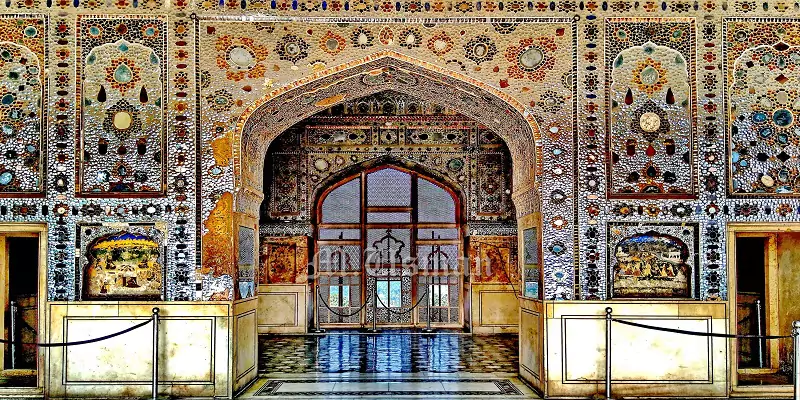Sheesh Mahal
The Sheesh Mahal, or the Palace of Mirrors, situated within the historic Lahore Fort in Lahore, Pakistan, stands as a glittering testament to the opulence and artistic prowess of the Mughal Empire. This architectural marvel, constructed during the reign of Emperor Shah Jahan in the 17th century, encapsulates the grandeur, innovation, and aesthetic sophistication characteristic of Mughal architecture. The Sheesh Mahal is not just a physical structure; it is a manifestation of the Mughals' ability to blend practical functionality with unparalleled beauty, creating a space that transcends time.
The construction of the Sheesh Mahal is closely linked to the larger Lahore Fort complex, which served as the seat of Mughal power in the region. Commissioned by Shah Jahan, the fifth Mughal Emperor, the Lahore Fort underwent significant expansion and renovation during his reign. The Sheesh Mahal was conceived as a part of these enhancements, and its construction was completed in 1631.
The location of the Sheesh Mahal within the Lahore Fort is strategically significant. Positioned near the fort's Akbari Gate and Diwan-i-Khas, the Sheesh Mahal is situated in a central area, emphasizing its importance in the Mughal court's ceremonial and administrative functions.
As one approaches the Sheesh Mahal, the first impression is awe-inspiring. The exterior, built with a rich blend of white marble and red sandstone, showcases intricate carvings and delicate embellishments. The transition from the fort's courtyards to the Sheesh Mahal's entryway is marked by a sense of anticipation, heightened by the anticipation of the breathtaking spectacle that awaits within.
The name "Sheesh Mahal" is derived from the magnificent mirror work that adorns its interiors. The Sheesh Mahal is renowned for its intricate mirror mosaics, a dazzling display of artistic ingenuity. The purpose behind the extensive use of mirrors goes beyond mere ornamentation; it serves a dual function of aesthetic enhancement and practical illumination. The mirrors were strategically placed to reflect natural light during the day and candlelight in the evening, creating a mesmerizing play of light and shadow.
Upon entering the Sheesh Mahal, visitors are transported into a world of unparalleled beauty. The main hall is an expansive space adorned with intricate mirror work on the walls, ceiling, and even the floors. The reflection of light creates a celestial atmosphere, giving the impression of being surrounded by a myriad of stars. The effect is heightened by the presence of a central pool in the hall, further enhancing the play of light.
The Sheesh Mahal is not a singular space but a complex of rooms and chambers. Each room within the palace is adorned with unique mirror patterns, creating a sense of variety and richness. The quality of craftsmanship in the mirror work is truly exceptional, with delicate floral motifs, geometric patterns, and calligraphy enhancing the overall aesthetic appeal.
The central chamber of the Sheesh Mahal, often referred to as the Baradari, is particularly noteworthy. This octagonal room served as a private audience hall for the emperor, where he would receive select dignitaries and engage in discussions. The Baradari's design is a masterpiece, featuring a central pillar adorned with mirrors and surrounded by alcoves, each with its unique mirror patterns.
The Sheesh Mahal is not limited to visual aesthetics; it engages multiple senses. The acoustics of the palace are finely tuned, allowing for whispers to be carried across the chambers. This feature adds an element of intimacy and secrecy to the space, reflecting the nuanced nature of the Mughal court's interactions.
The mirror work in the Sheesh Mahal is not confined to the walls and ceilings alone; it extends to furniture and other elements within the palace. The incorporation of mirror work into everyday objects showcases the Mughals' commitment to creating a cohesive and harmonious visual experience.
Beyond the architectural and artistic brilliance, the Sheesh Mahal has historical significance. It served as a venue for important events, including royal receptions and celebrations. The palace also played a role in the intricate courtly rituals of the Mughal Empire, where symbolism and aesthetics were integral components of governance.
The Sheesh Mahal has weathered the passage of time and faced challenges such as natural deterioration and human interventions. However, restoration efforts, both historical and contemporary, have aimed to preserve this cultural treasure. The delicate process of restoring the mirror work requires a meticulous approach to maintain the palace's authenticity while ensuring its structural integrity.
The Sheesh Mahal is not an isolated entity within the Lahore Fort; it is part of a larger narrative that spans centuries. The fort itself, with its various structures and gardens, reflects the evolution of the Mughal Empire and the subsequent chapters of history that unfolded in the Indian subcontinent. The Sheesh Mahal stands as a jewel within this larger historical tapestry, offering a glimpse into a bygone era.
In conclusion, the Sheesh Mahal in Lahore is more than an architectural gem; it is a living testament to the Mughals' artistic brilliance and cultural sophistication. Its mirror work, architectural finesse, and historical significance combine to create a space that transcends its physical boundaries. As visitors walk through its hallowed halls, they step into

